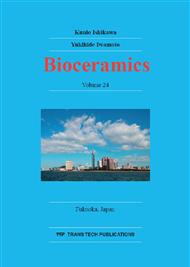p.379
p.385
p.391
p.397
p.402
p.407
p.413
p.417
p.421
Three-Dimensional Culture of Vascular Endothelial Cells Using Vascular Endothelial Growth Factor-Loaded Apatite-Fiber Scaffolds with Enhanced Mechanical Property
Abstract:
We have successfully developed the apatite-fiber scaffold (AFS) with enhanced mechanical porosity for tissue engineering of bone and liver via two routes: i) use of two type of carbon beads with diameter of ~150 μm and ~20 μm and following ii) uniaxial pressing of the green compacts. Our Aim is to add vascular formation ability into the above AFS in order to maintain the regenerated tissues for a long time. In the present study, the AFSs with various porosities (68±2.4, 85±1.5, 89±0.6, 92±1.0%) were fabricated, and then loaded with vascular endothelial growth factor (VEGF). Drug release from VEGF-loaded AFSs with various porosities was examined by immersing them into phosphate buffer. The AFSs with the highest porosity (92%) could be released with the most VEGF among examined AFSs. In addition, we carried out preliminary study for the compatibility of vascular endothelial cells, M1 cells established by Matsuura et al. to the VEGF-loaded AFS (porosity: 92%), in order to account for the vascular formation into the pore of the AFS. The numbers of M1 cells cultured in/on the VEGF-loaded AFS were about 1.5 times that of VEGF-free AFS over a period of cell culture. These results demonstrate that the VEGF-loaded AFS with enhanced mechanical property have a good compatibility to the M1 cells as a model of vascular endothelial cells.
Info:
Periodical:
Pages:
402-406
Citation:
Online since:
November 2012
Authors:
Price:
Сopyright:
© 2013 Trans Tech Publications Ltd. All Rights Reserved
Share:
Citation:


